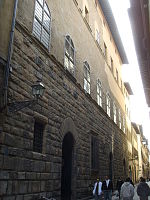Museo di Firenze com'era
Art museums and galleries in FlorenceItalian museum stubs

Museo di Firenze com'era ("Museum of Florence as it was") was a history and archaeology museum, one of the civic museums of the city of Florence. The museum was located on Via dell'Oriuolo in a former convent of the Oblates. It closed permanently in October 2010 to make space for the enlargement of the Biblioteca delle Oblate. Some of its exhibits will be incorporated into a new City museum portraying Florence through the ages, to be housed in Palazzo Vecchio.The museum's collections included the 14 surviving paintings of Medici villas by Giusto Utens. These were transferred in 2014 to a new permanent gallery at Petraia Villa Medici.
Excerpt from the Wikipedia article Museo di Firenze com'era (License: CC BY-SA 3.0, Authors, Images).Museo di Firenze com'era
Via Sant'Egidio, Florence Quartiere 1
Geographical coordinates (GPS) Address Nearby Places Show on map
Geographical coordinates (GPS)
| Latitude | Longitude |
|---|---|
| N 43.7724 ° | E 11.2601 ° |
Address
Complesso delle Oblate
Via Sant'Egidio
50122 Florence, Quartiere 1
Tuscany, Italy
Open on Google Maps








